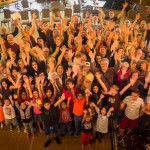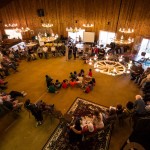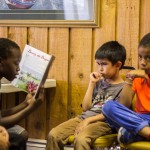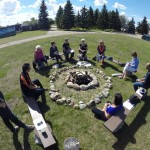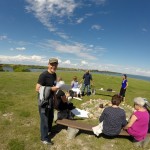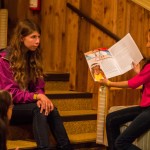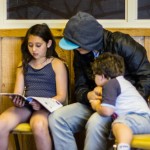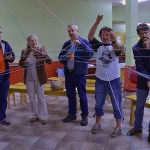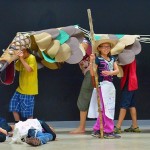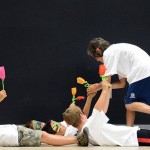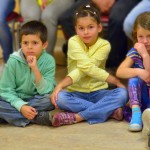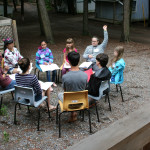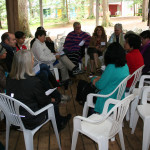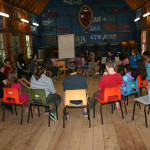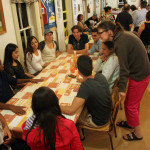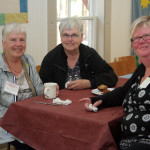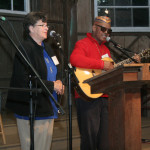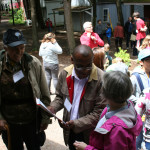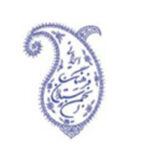Saskatchewan Summer School widens the circle of friends
The Saskatchewan Bahá’í Summer School kicked off a new group dynamic that participants are taking back to their communities this fall. The adult program at the school, which was held 29 to 31 August near Saskatoon, adopted a similar model to the one used last year for the 114 youth conferences held throughout the world: between plenary sessions led by Deloria Bighorn, a member of the National Spiritual Assembly of Canada, adult participants worked in three units of approximately 20 people each. These units studied the conference materials, which explored the themes of mutual support and assistance, and community building. They then mapped their communities and identified initiatives they could pursue in those settings after the summer school.
A facilitator of one of the three units described the school as “most successful in size and quality” and “participatory.” He also said that the school “had a really good spirit which really kicked off a new level of engagement with the plan,” and that “adults are not just doing background support for the youth but are to be involved in the same dynamic.” The facilitator explained that this helped everyone present feel involved by giving them insight into the structure youth have been using and learning about since the 2013 youth conferences.

Part of the program for junior youth included reading to the children’s group. Pictured here is an animator reading to two children at the summer school.
Most people viewed studying in units as a very positive element. One participant noted that the units provided the “opportunity to study and share,” and to be “in manageable groups, having a regular rhythm of meeting all together.” Another participant described the structure of the units as, “engaging,” explaining that “the study questions helped us gain insights into our own reality.” The questions also helped this participant “assess desires, motivations and barriers,” while working in a group provided “a support system, a place to freely share without judgment.”
The school had 105 participants, 20 of whom were from the wider community. The school was chaired by a friend of the Bahá’í community of Saskatoon. A participant who had recently begun learning about the Bahá’í Faith said, “The material we studied had a great impact on me; there were more insights from studying them than there seemed to be at face value. Being in the circle with people sharing was touching. They were mostly strangers who I had just met, but I felt a connection with them.” She found it uplifting that the participants were eager to make plans, and interested in how they could best support one another.
The school also had a strong program for the 24 children, six junior youth and ten youth present. Parents commented that the school was family-friendly. A room was even set aside at the facility for families, providing them with a place to rest.
The school opened and ended with a talking circle guided by Ms. Bighorn. She provided an object for the “talking stick” that had deep resonance for many in attendance. The object was a bracelet that had belonged to Mona Mahmudnizad, the 17-year-old Bahá’í who was imprisoned and executed in Iran in 1983 along with nine other Bahá’í women. Her crime had been teaching Bahá’í children’s classes. The story Ms. Bighorn shared about Mona and how the bracelet came to her brought tears to many. This “contact with a martyr” connected us with sacred reality at the very beginning of the weekend.
Participants learned to continually adjust the size of the circle to allow for those who could not be in the circle for the whole of a session, to join—a practical expression of the theme of the entire school: widening the circle of friends and helping each person to feel included.
Saskatchewan Summer School
- sask summer school 4
- sask summer school 11
- sask summer school 5
- GOPR4469
- GOPR4486
- sk summer school 1
- SK summer school 7
Quebec Summer School
- quebec ecole 03
- quebec enfants 03 3
- Quebec summer school 1
- quebec Children 01 3
Maritime Summer School
- friends in classes and breakout sessions 2
- friends in classes and breakout sessions 3
- friends in classes and breakout sessions1
- friends in common room 1
- friends in common room
- friends presenting 1
- friends presenting 2
- friends presenting 3
- friends socializing during a breakoutsession
Category: Highlights

